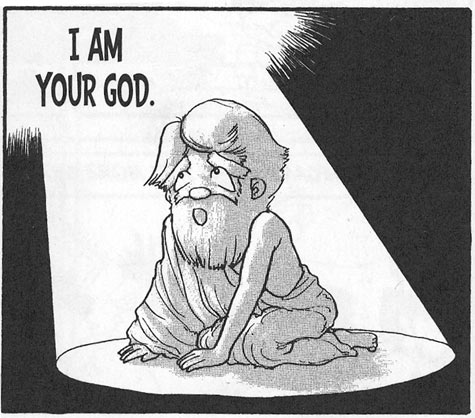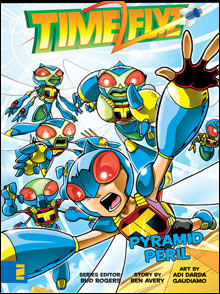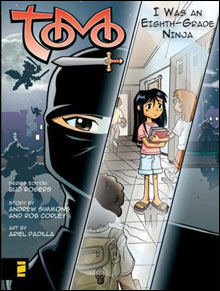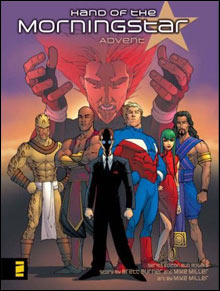
Panel from The Manga Bible
Posted on 10/11/2007 4:28:46 PM PDT by Alex Murphy

Panel from The Manga Bible
Young Laurel Templeton spends her summer vacation “kidnapped by five cyborg flies and shrunk down to insect size so [she can] travel back in time with them to save the world from an evil spider.” You know, typical stuff.
A manga comic character and the star of the new TimeFlyz series, Laurel may be just an average girl, but she has a centuries-old, ancient-Hebrew-speaking friend with whom she can’t communicate, and a Nobel Prize–winning father who has been kidnapped by a deranged arachnid named Darchon. By the end of Pyramid Peril, the first installment of her story, she’s vowed to assist the cyborg flies in defeating Darchon and rescuing her father.
“They say, ‘From those to whom much is given, much is expected,’ ” Laurel realizes toward the end of TimeFlyz, Volume One. Although she thinks it’s a line from one of her little brother’s poems, that axiom is actually from the Bible — Luke, 12:48.
Yup, Bible verses are now being tossed around nonchalantly in a comic book. Laurel’s character is the most recent attempt by Zondervan — the Christian division of HarperCollins, which, with sales topping $1 billion this past year, is one of the biggest publishing houses in the world — to get . . . er, hip to what today’s kids are digging.
As opposed to other series in Zondervan’s new Z Graphic Novel line, introduced in August, there’s nothing explicitly religious about TimeFlyz; it’s just good, clean, moral fun — material that Christian bookstores can feel comfortable putting on their shelves, and that Christian parents can feel satisfied purchasing.
And yet the TimeFlyz series is being drawn in the popular Japanese manga style, a style that even a Zondervan-issued FAQ describes as one that “tend[s] to celebrate violence and sexual misbehavior.” That may seem a bit counterintuitive for a religious graphic novel, given the anti-pop-culture emphasis that pervades much of the Christian movement. After all, there’s not much about secular pop culture that can get by the Christian value-meter.
Take James Dobson, chairman of Focus on the Family, who says of the Harry Potter phenomenon: “We have spoken out strongly against all of the Harry Potter products.” The Focus on the Family Web site goes on to say that “Magical characters — witches, wizards, ghosts, goblins, werewolves, poltergeists, and so on — fill the Harry Potter stories, and given the trend toward witchcraft and New Age ideology in the larger culture, it’s difficult to ignore the effects such stories [albeit imaginary] might have on young, impressionable minds.”
Curiously, though, Zondervan has apparently deemed robotic flies that can travel through time to be cool — not devilish. So amid evangelicals railing in the mainstream media against Harry Potter and pop music as corrupting morality (remember, rock is the Devil’s music), Zondervan is quietly expanding on Christian efforts to adapt pop culture to evangelical ends. Like putting rock bands with drum kits next to the altar, or video screens above the pews, Christian graphic novels suggest a compromise approach: if you can’t beat ’em, join ’em — and do some proselytizing while you’re at it. In other words, a little fantasy is okay, as long as it’s morally stamped and approved.
 |
The Zondervan folks know a profitable trend when they see one, and they see one in manga.
A Japanese comic motif (literally translated: “whimsical pictures”), manga’s visually unique style is reminiscent of anime in film — mostly because of the characters’ big eyes, black-and-white illustrations, and exaggerated emotions. According to Zonderkidz vice-president Alicia May, the market for manga with American kids and teens has tripled in the past three years. It’s especially popular with young girls, who make up 60 percent of manga readers. American sales of manga are estimated to be around $300 million per year, and industry experts say it is one of the fastest-growing fiction categories in North America.
Meanwhile, Christian literature in general continues to enjoy rising popularity: the Evangelical Christian Publishers Association (ECPA) reports that the US market for all religious books in 2004 (the most recent statistics available) was 11.4 percent of the overall $2 billion market, and more than 85 percent of those were Christian titles. In 2005, the ECPA commissioned a study that showed the Christian-book market is growing “at a faster pace than the industry average,” and that Christian book-buyers spend more money on books annually than those who purchase non-religious books.
From a business perspective, then, it makes sense that Zondervan would develop Z Graphic Novels, which use loose interpretations of manga style to tell biblical, superhero, and fantasy stories. Two volumes each of six series have been issued so far; 48 volumes total are planned for the next four years. Evidently, they intend to do well by doing good.
And Zondervan isn’t the only company promoting a multi-year Christian-manga contract. Earlier in 2007, the publisher Thomas Nelson Inc. announced it would release 10 faith-based manga titles, within the Serenity and Goofyfoot Gurl series. (Goofyfoot Gurl debuted this past month.) These aren’t low-profile deals. They’re even getting props from comics don Stan Lee (oh, just the co-creator of Spider-Man, X-Men, and the Hulk), who described Serenity as “a clean, inspiring teen-aged Christian comic done in a hip, contemporary way.”
‘A healthy alternative’
For all the spiritual sameness of this new breed of Christian comics, the Zonderkidz offerings are thematically rather diverse. There’s the Manga Bible, which is what it sounds like — a retelling of the Bible, in comic-book form. (“Did you know . . . um . . . that you’re naked?!” the original sinner asks her companion in the Manga Bible’s version of the fall from grace. “Ahem! You’re naked too . . . hum . . . embarrassing.”) The Son of Samson and Kingdoms: A Biblical Epic series both depict biblical characters in historical settings. And TimeFlyz, Tomo, and Hand of the Morningstar’s morality plays aren’t directly tied to the Bible, even though the stories are presented “with a Christian perspective based on biblical values.”
TimeFlyz, as mentioned above, is about a female time-traveler who learns spiritual and moral lessons on her journeys; Tomo is the story of a young Japanese girl who moves to America and battles otherworldly, animal-like warriors, also learning faith-based lessons along the way. Morningstar follows the adventures of super-powered beings who serve a heavenly creature who may or may not be evil — a large-scale allegory of the battle between heaven and hell.
 |
“Unfortunately, the current fare often exposes its readers to strong sexual imagery, gratuitous violence, and pagan worldviews,” says Zonderkidz vice-president May of secular graphic novels, only some of which are explicitly intended for children. “We created Z Graphic Novels as a healthy alternative.”
To that end, theology professors and pastors were hired as Zondervan’s “theological reviewers,” tasked with assessing the books, says May, “based on theological accuracy, clarity of message, and appropriateness for the intended age group’s faith development.”
(One can’t help but wonder how this exchange, which opens the Manga Bible’s Book of Genesis, got by the reviewers: “Okay now, listen Lord, take whatever you need. She should have a smooth complexion, big brown eyes, a cute little nose, and full red lips. . . . Oh! And don’t forget, her measurements should be . . .” “Keep it up, Adam, and I won’t use anesthesia during this surgery!”)
The reviewers then recommend changes. One TimeFlyz character used language that one reviewer thought was too reminiscent of an arcane sect of Christianity, which launched a theological discussion (ultimately the dialogue was kept as is), says TimeFlyz and Kingdoms story writer Ben Avery, a Protestant who lives in Indiana. But for the most part, Avery — who has also worked on secular comics, such as an adaptation of The Hedge Knight and The Oz/Wonderland Chronicles — finds this type of work liberating. He appreciates being able to celebrate his faith in his professional life.
“I not only can be a little more blatant, I have to be more blatant about things like God and spirituality,” he says. “It’s freeing, because I get to actually say some of the things I want to say, and not have to hide it in metaphor.”
BattleCry
“Certainly, if you’re going to produce comics — Christian comics or comics, period — they’ve taken the right approach by going with the graphic novels,” as opposed to comic strips or more traditional short-form serial comics, says Nate Butler, president of COMIX35, an organization that trains international artists to produce Christian cartoons and comics in places such as Japan and Australia. “Zondervan has made the right call there, to capitalize on the trend.”
Indeed, combine the developing popularity of graphic novels with the growing market for Christian literature in general — and throw in the fact that the Bible is the best-selling book of all time — and you have a winning business model.
“If you went to Barnes and Noble, it used to be that there was one bay of graphic novels,” says Avery. “Now it’s huge. That’s what kids are buying, that’s what people are interested in. Zondervan specifically wanted to tap that market.”
It makes sense: Christians don’t want to do away with comics or books or music — they just want to make sure they’re created, and consumed, their way. (There are some real crazies who disagree with the concept of Christian rock entirely because pop music is evil, but they’re in the minority.)
These publishing houses are simply doing what megachurches, musicians, and Christian role models have done before: recreating popular culture in piety’s image. Rather than waste their time criticizing Harry Potter or railing against rock music, many believers are immersing themselves, and their children, in Christian alternatives.
Earlier this year, 71,414 people attended BattleCry events in San Francisco, Detroit, and Bristow, Virginia. The brainchild of Teen Mania Ministries, BattleCry is a Texas-based national organization that urges teenagers to reject popular culture in favor of a teen culture that embraces Jesus Christ. At those events, thousands of teens listened to Christian-rock music (from bands such as P.O.D. and Casting Crowns), participated in a stadium-scale worship service, and, at least in San Francisco, watched a performance by “hip-hop evangelists who use their fast feet to communicate God’s love,” according to the BattleCry Web site.
 |
“Sometimes I think we, as adults, make teaching the Bible boring,” Russo says on the phone from his house in California. “It can be fun. I believe the spiritual truth is everywhere. It’s just a matter of being able to see it through a different lens and apply a biblical filter.” Russo knows that some in the Christian community will chastise him — “How dare you find spiritual truth in a Disney movie” — but he maintains that “I don’t think something is bad because it’s secular. There are a lot of things that we can appreciate in life that are not necessarily sacred.”
Even better, there are lots of secular, popular (and titillating) trends, such as manga or hot-young-celebrity musicals, that can be adapted to meet the tastes of a sacred audience. Z Graphic Novels, along with the Serenity series and other independent Christian comics, are the latest incarnation of this ability to adapt.
In fact, Christian publishers may be so eager to co-opt the manga genre that they are prematurely labeling themselves as such.
“The Zondervan [FAQ] misrepresents both the form and the content of manga,” Douglas Wolk, a well-known pop-culture critic and the author of Reading Comics: How Graphic Novels Work and What They Mean (and occasional Phoenix contributor), writes in an e-mail. “ ‘Manga’ is usually used to refer to comics in a specific range of visual styles developed in Japan, which isn’t true of a lot of Z’s stuff, and to say that ‘many manga series also tend to celebrate violence and sexual misbehavior’ is pretty misleading. (Some represent them, but representation and endorsement are not the same thing.)”
Even Butler, of COMIX35, questions Zondervan’s decision to market Z Graphic Novels as manga: “I’m a little surprised that they’re calling it that,” lest manga-loving young readers start to believe that “Christians are a little tone deaf about what [kids] are really looking for.”
Disclaimer: Opinions posted on Free Republic are those of the individual posters and do not necessarily represent the opinion of Free Republic or its management. All materials posted herein are protected by copyright law and the exemption for fair use of copyrighted works.